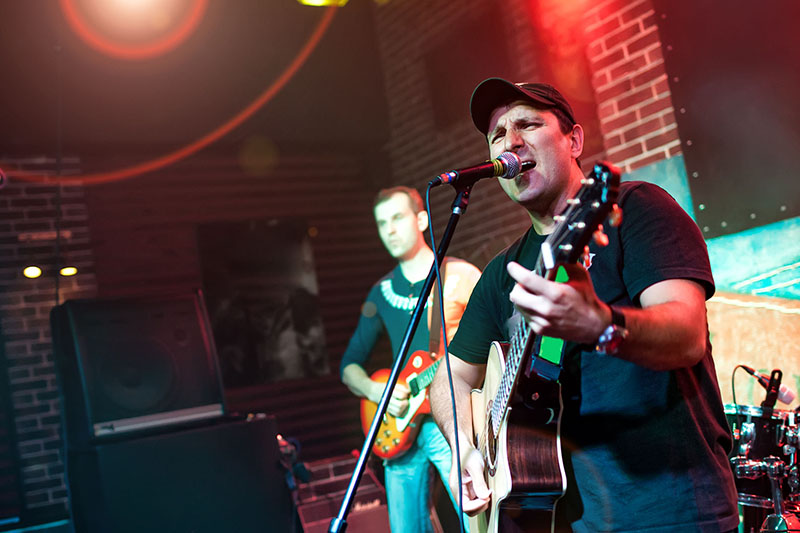
Scott Holtzman: Acoustic guitars provide a unique set of challenges. The acoustic on many shows does not receive the attention of the electric guitar and the result is the instrument is not presented in the best possible light. The two most common pickups are the piezo and the EM (electromagnetic) styles.
EMs are easy to work with but impart an almost electric quality to the instrument – they don’t have the presence peak of a piezo. I try not to over-EQ EMs, and some require a lift in the very high end via a shelf filter on the parametric to bring some “air” out of the instrument.
Piezos represent a much larger challenge as they tend to require drastic EQ to control the presence peaks. The key is a good direct box (DI). The best is the Radial PZ-DI, which has input impedance matching that allows the engineer to vary the input impedance to achieve the best match (and most linear response).
Once a decent gain structure is attained (don’t overdrive those preamps on a digital desk!), use the “search and destroy” method with the parametric EQ. A single deep cut or boost is swept to locate the most offensive peak. Keep it as narrow as possible.
Once that frequency is located make that cut very deep. A cut around 400 Hz will be needed if there’s too much energy in that region. I also try to find a frequency around 500 Hz that “warms” the sound back up and gives it fullness and energy in the mix. Lastly, address any upper end issues.
Jeremy Grodhaus: When it comes to miking a guitar cabinet, I’m not that particular as to what comes down the line or how it got to me as long as it sounds appropriate at the source. I say appropriate because good tone is completely subjective, and although I may really like or dislike a particular tone, it may be exactly what the artist is looking for. If artists are looking for input, I happily give it but I always assume they have their thing going and aren’t looking for unsolicited advice.
Beyond that, however, I prefer a live guitar amp to mic up. It’s where engineers can be creative in subtle ways, and we can help ourselves – right at the source – tweak the final mix. This is now where we take something that’s already subjective and pile more subjectivity onto it (LOL).
My go-to mic is an SM57. I try to listen to the amp during setup to make a determination if I want to lean on the brighter or darker side of things. Then I point the mic accordingly. If it’s bright (maybe a Telecaster through a Fender) the mic goes in front of the dust cap but pointed to the edge of the cone. If it’s dark, it’s the opposite, placed in front of the edge and pointing towards the dust cap.
If it’s really dark, I put the mic right in front of the cap, and if it’s really bright I put it right in front of the edge. The speaker is kind of like a drum head – lots of top end in the center and lots of “tub” and low end on the outside.
Different mics have different responses, but the basic placement is the same. If I go for my ribbon mic, I can usually deal with a lot more brightness because the mic rounds that out. If I’m using an large-diaphragm condenser, maybe not so much.
I’ve also had a lot of fun miking the back of the cab in an open back scenario. There is lots of tone back there and sometimes it can really add to the mix, especially if the instrumentation is small (like a trio). Do some judicial panning and/or delay and now you’ve got a nice fat and wide guitar tone that takes up some space.
Once, an amp went down in the first set at a club show I was working. My young, naive self decided that we just needed to simulate an amp sound. So I slapped a DI after the pedals, overdrove the transistor head amps on the console (analog) and fed it back to a monitor, then miked the monitor. It sounded terrible.
The lesson learned is that there’s a lot going on with guitar amps and having the right tone from the beginning is what makes all the difference. We can only affect so much once it gets to us. Get it right at the start and 80 percent of the job is done before you even walk up front.
Erik Matlock: Let’s go with acoustic guitars. In an ideal situation, I’d have a crate of DPA 4099 mics with the acoustic guitar body mount for every acoustic instrument. However, I don’t normally have spare DPAs laying around. Lacking those 4099s, when I have plenty of time to sound check and set up, I prefer to use a pencil condenser along the neck to pick up the fingers on the frets and a large diaphragm near the body.
When I’m in the studio, the first part of the setup involves actually listening to the instrument for a few minutes and finding the sweet spots, picking suitable mics and adjusting the setup until we’re happy. Live situations don’t always allow that much time, in fact, it’s rare. Since the bulk of my live mixing has historically been on analog consoles with unfamiliar artists in random venues as a hired gun, I’ll focus on a common setup for multi-act events.
